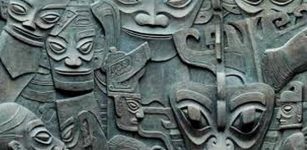How Common Were Tattoos Among Vikings And Norse People?
Ellen Lloyd AncientPages.com - Archaeologists have found evidence that people in almost all corners of the world have practiced tattooing for thousands of years. Tattoos are a part of various cultures worldwide, serving diverse purposes and holding numerous significances.
In ancient times, Siberian nomads, Indigenous Polynesians, Nubians, Native South Americans, Greeks, and ancient Egyptians, just to mention a few, embraced tattoos for various reasons. These included protection from evil, declarations of love, signifying status or religious beliefs, adornments, and even forms of punishment. The practice of tattooing has been deeply rooted in cultural traditions across different societies, reflecting the rich tapestry of human expression and symbolism.
Anyone who visits Scandinavia today will find that both men and women are very fond of tattoos and gladly cover their bodies with various symbols of all sizes, shapes, and colors. But what attitude did Norsemen have towards tattoos? Did ancient Vikings wear tattoos, and if so, why?
Is There Any Evidence Of Norse Tattoos?
We do know that the Celts and Northern European tribes, such as the Picts, which literally means “painted people,” all practiced some form of tattooing, but the subject becomes more complex when Vikings are concerned.
As mentioned by Ancient Pages, men and women were vain and very clean during the Viking Age. Scientists have discovered tweezers, combs, razors, nail cleaners, ear cleaners, and toothpicks inside Viking tombs. All these Viking artifacts show that people of the Viking Age cared greatly about personal grooming.
Credit: IMDb - Fair use
However, whether Vikings also wore tattoos remains uncertain. So far, archaeologists have not discovered any ancient remains of Vikings who had covered their bodies with tattoos. This doesn’t exclude the possibility that Vikings didn’t bother with tattoos, but there is no conclusive evidence this was the case.
The problem with investigating the history of ancient tattoos is that skin is fragile and rarely survives burials. Like most Viking clothes rotted away and disappeared when archaeologists excavated their tombs, the same applies to finding traces of ancient tattoos.
Also, we shouldn’t forget that Viking funeral traditions and rituals were very complex. Not all Vikings were buried. A great Viking warrior received a ship burial, which involved placing the deceased on the ship, sailing him out to sea, and setting the ship on fire.
An ancient account indicating that Vikings enjoyed tattoos comes from al-Tartushi, an Arabic emissary who visited Hedeby in the tenth century.
Reconstructed house at Hedeby. Image credit: Matthias Süßen - CC BY-SA 4.0
Hedeby was a prestigious trading center and one of the largest Baltic Sea ports in Viking Age.
al-Tartushi documented his travel experiences and encounters with the Vikings. Unfortunately, his work did not survive, but its excerpts have been preserved in Arab geographical collections. From one account, we learn that al-Tartushi noticed that Vikings wore artificial eye makeup that never vanished. This made them look younger and more beautiful, he said. He also wrote that Vikings had tattoos on their arms and chests. These tattoos were strange patterns and symbols resembling animals and trees.
It’s an intriguing observation. Ancient Egyptian men wore eye makeup for a number of reasons, but the use of such cosmetics by males in Viking society has never been confirmed. Archaeologists have never discovered any eyeliner or mascara in Hedeby.
No other ancient sources have confirmed al-Tartushi’s claims.
Ahmad ibn Fadlan, a 10th-century traveler from Baghdad, met Swedish merchants whom he called the Rus at the bank of the Volga, where they exchanged goods with Muslim traders.
In his account, ibn Fadlan described the physical appearance of the Vikings saying: "I have seen the Rus as they came on their merchant journeys and encamped by the Atil [the Volga]. I have never seen more perfect physical specimens - tall as date palms, blond and ruddy. Each man wore a garment which covered his body on one side and left one side free for action. Each man carried an axe, a Frankish-Type sword and a knife with him. Tattoos covered him from finger-tip to neck. They drink wine excessively day and night."
We can conclude by saying it remains unknown how common or uncommon tattoos were in Norse society.
If Norse people used tattoos, then perhaps they picked one of the most popular Norse and Viking symbols we described in our previous article - 10 Viking And Norse Symbols.
Written by Ellen Lloyd – AncientPages.com
Copyright © AncientPages.com All rights reserved. This material may not be published, broadcast, rewritten or redistributed in whole or part without the express written permission of AncientPages.com
Expand for referencesKane, Njord. The Vikings: The Story of a People
Tibi Amin, The Vikings In Arabic Sources - Islamic Studies 35, no. 2 (1996): 211–17.
Hraundal, Thorir Jonsson. “New Perspectives on Eastern Vikings/Rus in Arabic Sources.” Viking and Medieval Scandinavia 10 (2014): 65–98.
More From Ancient Pages
-
 Evidence Supporting Drumelzier Legend And Merlin’s Death In Scotland Uncovered By Archaeologists
Archaeology | Sep 4, 2024
Evidence Supporting Drumelzier Legend And Merlin’s Death In Scotland Uncovered By Archaeologists
Archaeology | Sep 4, 2024 -
 Sir Christopher Wren – Genius Mind Of Most Influential British Architect Of All Time
Featured Stories | Feb 22, 2016
Sir Christopher Wren – Genius Mind Of Most Influential British Architect Of All Time
Featured Stories | Feb 22, 2016 -
 Prehistoric House Of The Dead Discovered In Wiltshire – Is This The Burial Place Of Ancestors Of Stonehenge Builders?
Archaeology | Jul 17, 2017
Prehistoric House Of The Dead Discovered In Wiltshire – Is This The Burial Place Of Ancestors Of Stonehenge Builders?
Archaeology | Jul 17, 2017 -
 Impressive And Rare Hoard Of Silver Coins Dated To The Hasmonean Period (126 BC) – Studied
Archaeology | Oct 14, 2021
Impressive And Rare Hoard Of Silver Coins Dated To The Hasmonean Period (126 BC) – Studied
Archaeology | Oct 14, 2021 -
 More Than 27,000 Artifacts Illegally Collected By ‘Expert In Archaeology’ – Seized In France
Artifacts | Dec 18, 2020
More Than 27,000 Artifacts Illegally Collected By ‘Expert In Archaeology’ – Seized In France
Artifacts | Dec 18, 2020 -
 Incredible Trove Of 100,000 Ancient Coins Tied Together In Bundles Uncovered In Japan
Archaeology | Nov 13, 2023
Incredible Trove Of 100,000 Ancient Coins Tied Together In Bundles Uncovered In Japan
Archaeology | Nov 13, 2023 -
 Cato The Younger – Mortal Enemy Of Julius Caesar Was A Man Who Hated Luxury, New Ideas And Was Immune To Bribes
Featured Stories | Apr 17, 2021
Cato The Younger – Mortal Enemy Of Julius Caesar Was A Man Who Hated Luxury, New Ideas And Was Immune To Bribes
Featured Stories | Apr 17, 2021 -
 Rhetorica ad Herennium: Ancient Book That Improves Your Memory Using Method Of Loci – You Can Test It Easily
Featured Stories | Nov 13, 2023
Rhetorica ad Herennium: Ancient Book That Improves Your Memory Using Method Of Loci – You Can Test It Easily
Featured Stories | Nov 13, 2023 -
 Long-Lost Artifact Re-Discovered In Michigan Offers Evidence Of Overseas Visitors In Pre-Columbian Times
Legends And Mysteries Of North America | Jul 16, 2024
Long-Lost Artifact Re-Discovered In Michigan Offers Evidence Of Overseas Visitors In Pre-Columbian Times
Legends And Mysteries Of North America | Jul 16, 2024 -
 Enigmatic Human Fossil Jawbone May Be Evidence Of An Early Homo Sapiens Presence In Europe
Evolution | May 2, 2023
Enigmatic Human Fossil Jawbone May Be Evidence Of An Early Homo Sapiens Presence In Europe
Evolution | May 2, 2023 -
 Mysterious Death Of 20 Celts Who Died 2,000 Years Ago In The Three Lakes, Switzerland – Re-Examined
Archaeology | Jun 17, 2024
Mysterious Death Of 20 Celts Who Died 2,000 Years Ago In The Three Lakes, Switzerland – Re-Examined
Archaeology | Jun 17, 2024 -
 Large Roman Public Latrine With 60 Wooden Seats Discovered In Bet Shean, Israel
Archaeology | Sep 25, 2023
Large Roman Public Latrine With 60 Wooden Seats Discovered In Bet Shean, Israel
Archaeology | Sep 25, 2023 -
 Baffling Sanxingdui Civilization: Why Did These People Have Fascination For Eyes?
Civilizations | Mar 21, 2017
Baffling Sanxingdui Civilization: Why Did These People Have Fascination For Eyes?
Civilizations | Mar 21, 2017 -
 Bronze Age Vatya Culture: ‘Urnfield’ Cemetery And Remains Of A High-Status Woman
Archaeology | Jul 30, 2021
Bronze Age Vatya Culture: ‘Urnfield’ Cemetery And Remains Of A High-Status Woman
Archaeology | Jul 30, 2021 -
 2,000-Year-Old Instruments Used By Roman Surgeons Revealed By Archaeological Scanners
Archaeology | Jul 17, 2024
2,000-Year-Old Instruments Used By Roman Surgeons Revealed By Archaeological Scanners
Archaeology | Jul 17, 2024 -
 Archaeologist Ludovic Slimak Wants To Rewrite The History Of Early Humans In Europe
Evolution | Jun 10, 2023
Archaeologist Ludovic Slimak Wants To Rewrite The History Of Early Humans In Europe
Evolution | Jun 10, 2023 -
 Secrets Of 2,000-Year-Old Tomb Of Cerberus Revealed To The Public
Archaeology | Jul 29, 2024
Secrets Of 2,000-Year-Old Tomb Of Cerberus Revealed To The Public
Archaeology | Jul 29, 2024 -
 Secret Kumari Kandam Continent And Links To Lemurians
Civilizations | May 18, 2020
Secret Kumari Kandam Continent And Links To Lemurians
Civilizations | May 18, 2020 -
 Code Of Nesilim: Ancient Laws Of The Hittites
Ancient History Facts | Jun 14, 2018
Code Of Nesilim: Ancient Laws Of The Hittites
Ancient History Facts | Jun 14, 2018 -
 Oldest Door Lock Comes From Ancient Egypt
Ancient History Facts | Jun 27, 2018
Oldest Door Lock Comes From Ancient Egypt
Ancient History Facts | Jun 27, 2018



